FORD MONDEO 2006 2.G Owner's Manual
Manufacturer: FORD, Model Year: 2006, Model line: MONDEO, Model: FORD MONDEO 2006 2.GPages: 198, PDF Size: 4.69 MB
Page 21 of 198
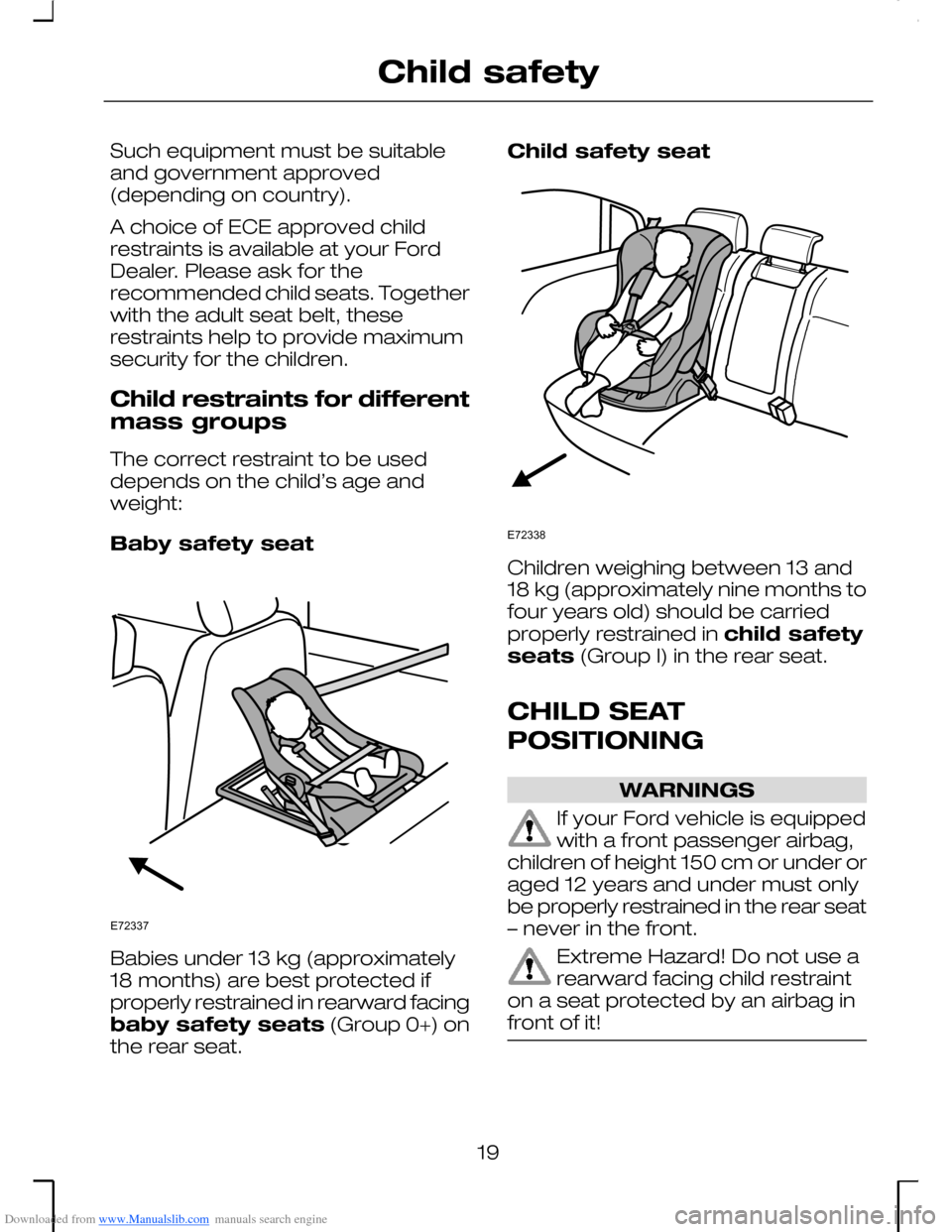
Downloaded from www.Manualslib.com manuals search engine Such equipment must be suitableand government approved(depending on country).
A choice of ECE approved childrestraints is available at your FordDealer. Please ask for therecommended child seats. Togetherwith the adult seat belt, theserestraints help to provide maximumsecurity for the children.
Child restraints for differentmass groups
The correct restraint to be useddepends on the child’s age andweight:
Baby safety seat
Babies under 13 kg (approximately18 months) are best protected ifproperly restrained in rearward facingbaby safety seats (Group 0+) onthe rear seat.
Child safety seat
Children weighing between 13 and18 kg (approximately nine months tofour years old) should be carriedproperly restrained in child safetyseats (Group I) in the rear seat.
CHILD SEAT
POSITIONING
WARNINGS
If your Ford vehicle is equippedwith a front passenger airbag,children of height 150 cm or under oraged 12 years and under must onlybe properly restrained in the rear seat– never in the front.
Extreme Hazard! Do not use arearward facing child restrainton a seat protected by an airbag infront of it!
19
Child safetyE72337 E72338
Page 22 of 198

Downloaded from www.Manualslib.com manuals search engine Note: If individual circumstancesrequire that a child weighing morethan 9 kg must travel in a front seatprotected by an operational frontairbag, only use a forward facingrestraint.
The following table advises on thesuitability of child restraint fitmentlocations.
Child seat positions
Mass group categoriesSeating positions
IIIIII0+0
22 to 36kg (about6− 12years)
15 to 25kg (about31/2 − 12
years)
9 to 18 kg(about 9months−4 years)
Up to 13kg (about0− 2years)
Up to 10kg (about0− 9months)
Boosterseat/cushion
Boosterseat/cushion
Childsafetyseat
Babysafetyseat
Babysafetyseat
U1U1U1XXFront passenger seat
UUUUURear seats
X = Seat position not suitable for children in this mass/age group.
U = Seat position suitable for universal category restraints approved for usein this mass/age group.
U1 = Seat position suitable for universal category restraints but Ford
recommends that children should be secured in an appropriate child restraintin the rear seats.
20
Child safety
Page 23 of 198
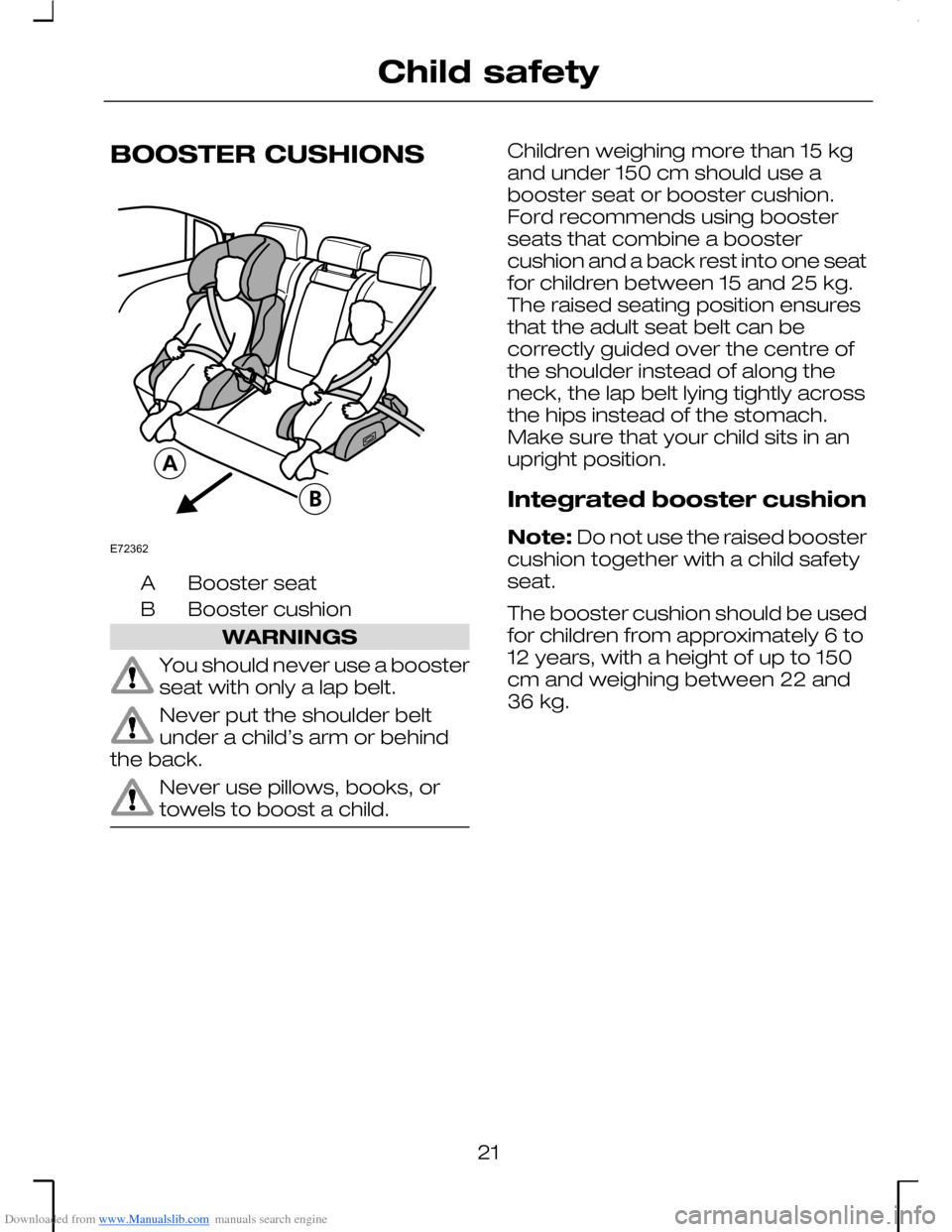
Downloaded from www.Manualslib.com manuals search engine BOOSTER CUSHIONS
Booster seatA
Booster cushionB
WARNINGS
You should never use a boosterseat with only a lap belt.
Never put the shoulder beltunder a child’s arm or behindthe back.
Never use pillows, books, ortowels to boost a child.
Children weighing more than 15 kgand under 150 cm should use abooster seat or booster cushion.Ford recommends using boosterseats that combine a boostercushion and a back rest into one seatfor children between 15 and 25 kg.The raised seating position ensuresthat the adult seat belt can becorrectly guided over the centre ofthe shoulder instead of along theneck, the lap belt lying tightly acrossthe hips instead of the stomach.Make sure that your child sits in anupright position.
Integrated booster cushion
Note: Do not use the raised boostercushion together with a child safetyseat.
The booster cushion should be usedfor children from approximately 6 to12 years, with a height of up to 150cm and weighing between 22 and36 kg.
21
Child safetyE72362
Page 24 of 198
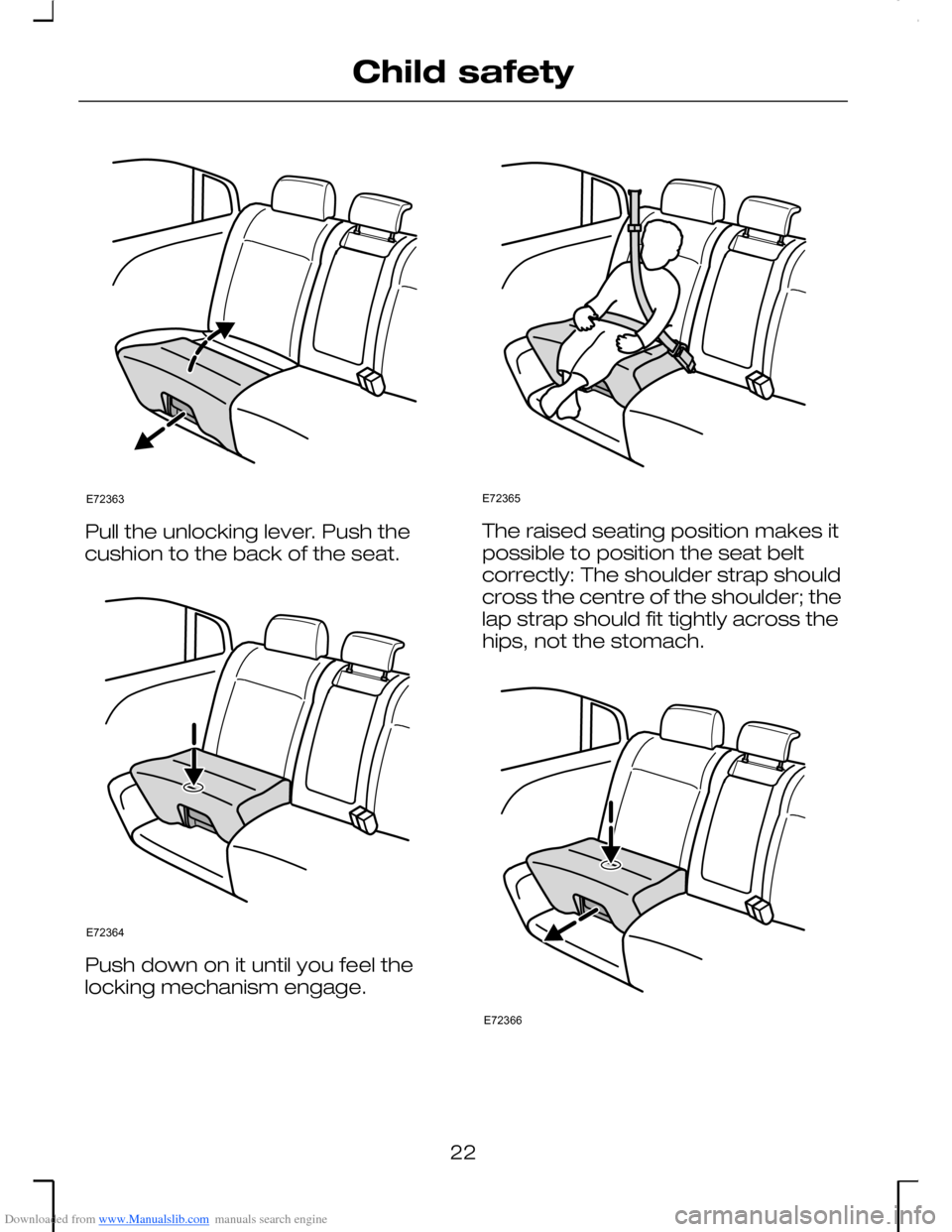
Downloaded from www.Manualslib.com manuals search engine Pull the unlocking lever. Push thecushion to the back of the seat.
Push down on it until you feel thelocking mechanism engage.
The raised seating position makes itpossible to position the seat beltcorrectly: The shoulder strap shouldcross the centre of the shoulder; thelap strap should fit tightly across thehips, not the stomach.
22
Child safetyE72363 E72364 E72365 E72366
Page 25 of 198
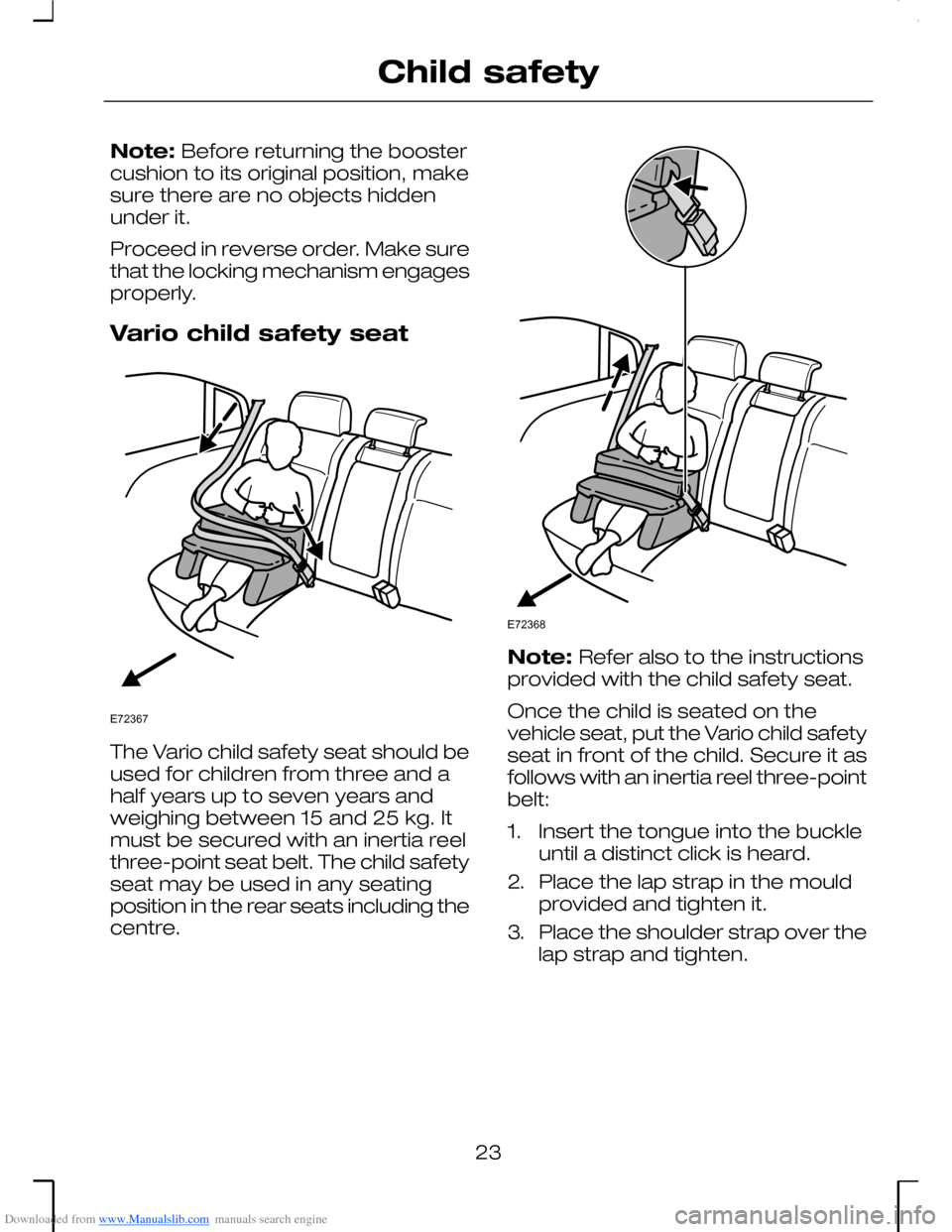
Downloaded from www.Manualslib.com manuals search engine Note: Before returning the boostercushion to its original position, makesure there are no objects hiddenunder it.
Proceed in reverse order. Make surethat the locking mechanism engagesproperly.
Vario child safety seat
The Vario child safety seat should beused for children from three and ahalf years up to seven years andweighing between 15 and 25 kg. Itmust be secured with an inertia reelthree-point seat belt. The child safetyseat may be used in any seatingposition in the rear seats including thecentre.
Note: Refer also to the instructionsprovided with the child safety seat.
Once the child is seated on thevehicle seat, put the Vario child safetyseat in front of the child. Secure it asfollows with an inertia reel three-pointbelt:
1.Insert the tongue into the buckleuntil a distinct click is heard.
2.Place the lap strap in the mouldprovided and tighten it.
3.Place the shoulder strap over thelap strap and tighten.
23
Child safetyE72367 E72368
Page 26 of 198
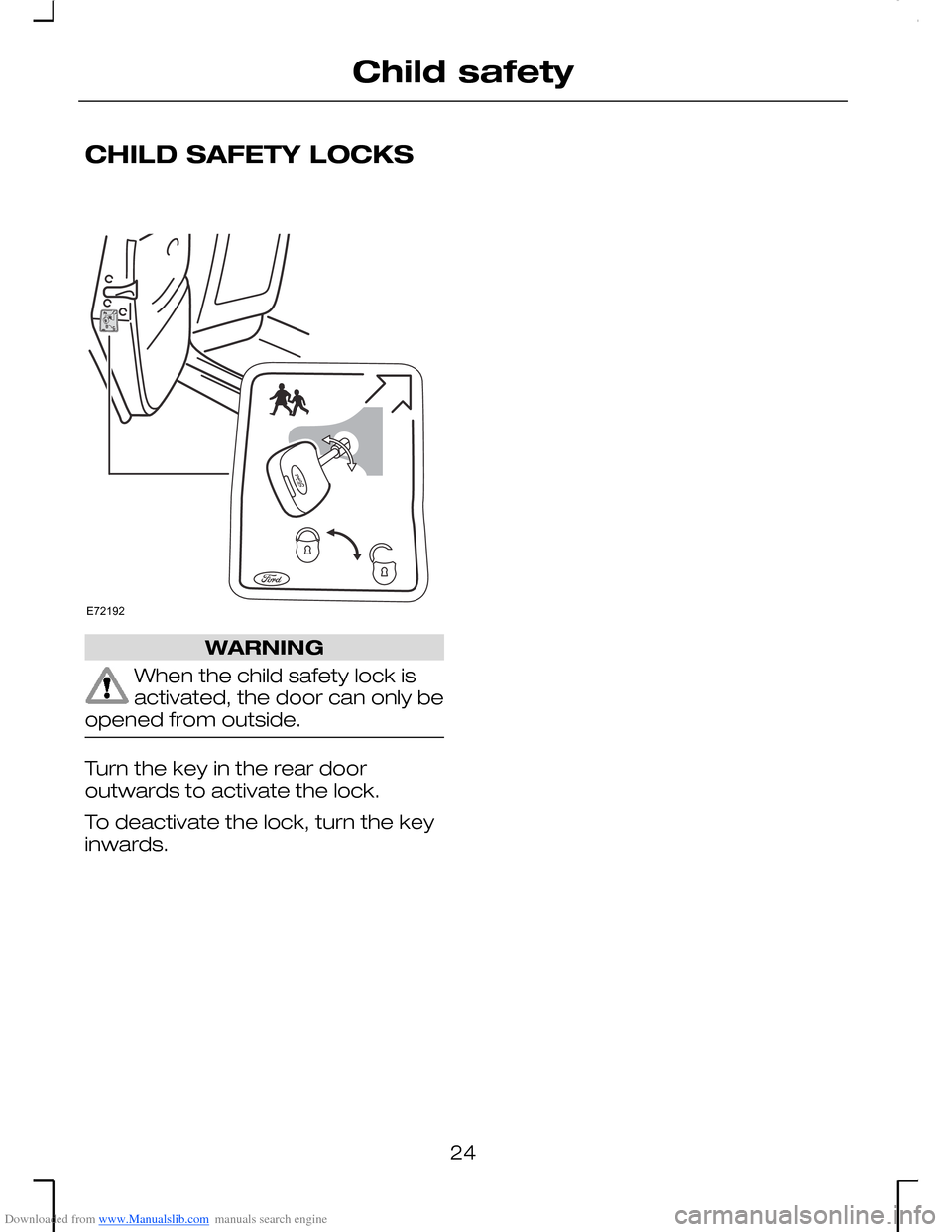
Downloaded from www.Manualslib.com manuals search engine CHILD SAFETY LOCKS
WARNING
When the child safety lock isactivated, the door can only beopened from outside.
Turn the key in the rear dooroutwards to activate the lock.
To deactivate the lock, turn the keyinwards.
24
Child safetyE72192
Page 27 of 198

Downloaded from www.Manualslib.com manuals search engine PRINCIPLE OF OPERATION
Airbags
WARNING
Do not modify the front of thevehicle in any way, as this canadversely affect the airbagdeployment.
Note: A loud bang will be heardwhen an airbag deploys and it isnormal to see a cloud of harmlesspowdery residue.
The airbag system comprises thefollowing:
•dual-stage inflatable nylon bags(airbags) with gas generators.
•side airbags
•curtain airbags
•seat belt pretensioners
•occupant sensors
•crash sensors.
•a warning lamp in the instrumentpanel.
•an electronic control anddiagnostic unit.
25
Occupant protectionE72324 E72330
Page 28 of 198
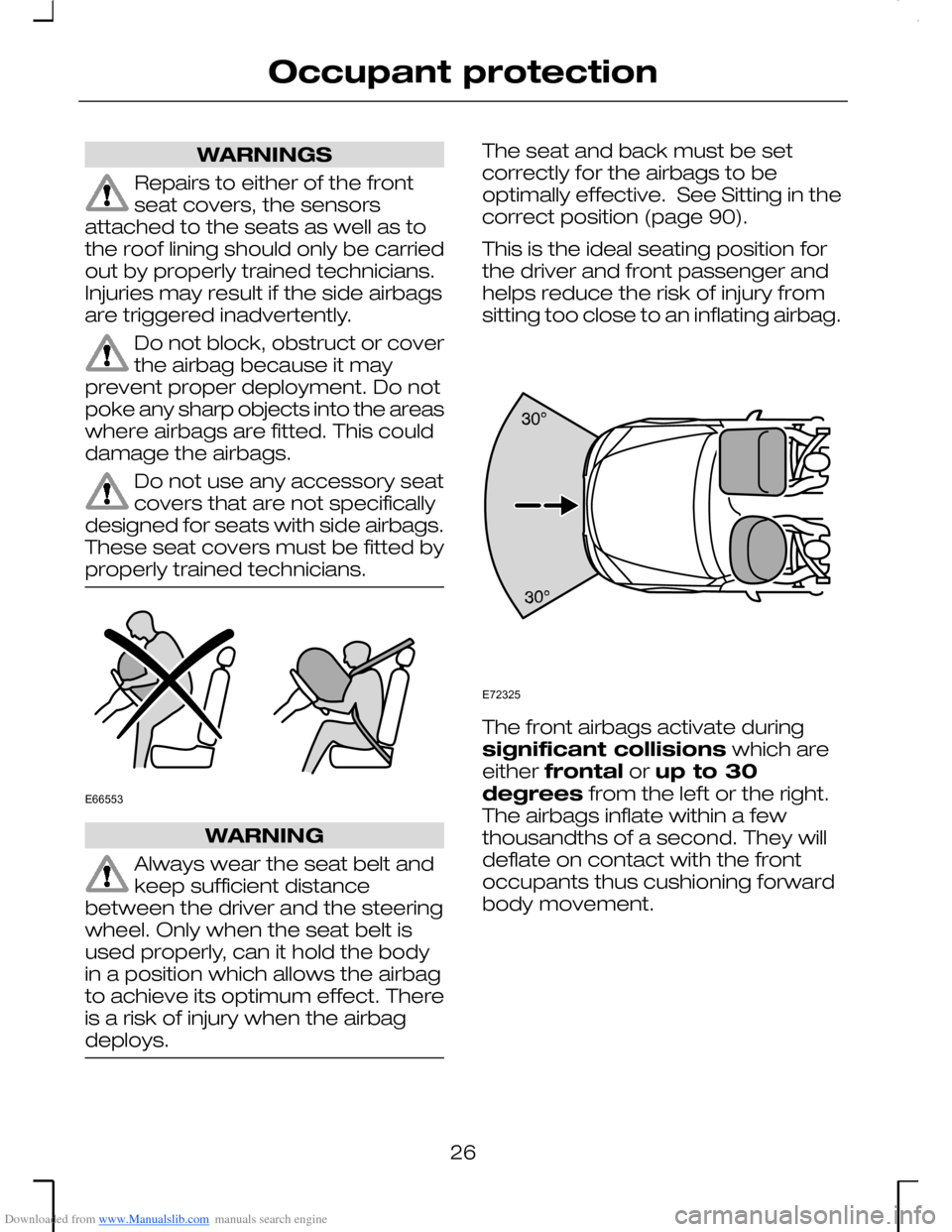
Downloaded from www.Manualslib.com manuals search engine WARNINGS
Repairs to either of the frontseat covers, the sensorsattached to the seats as well as tothe roof lining should only be carriedout by properly trained technicians.Injuries may result if the side airbagsare triggered inadvertently.
Do not block, obstruct or coverthe airbag because it mayprevent proper deployment. Do notpoke any sharp objects into the areaswhere airbags are fitted. This coulddamage the airbags.
Do not use any accessory seatcovers that are not specificallydesigned for seats with side airbags.These seat covers must be fitted byproperly trained technicians.
WARNING
Always wear the seat belt andkeep sufficient distancebetween the driver and the steeringwheel. Only when the seat belt isused properly, can it hold the bodyin a position which allows the airbagto achieve its optimum effect. Thereis a risk of injury when the airbagdeploys.
The seat and back must be setcorrectly for the airbags to beoptimally effective. See Sitting in thecorrect position (page 90).
This is the ideal seating position forthe driver and front passenger andhelps reduce the risk of injury fromsitting too close to an inflating airbag.
The front airbags activate duringsignificant collisions which areeither frontal or up to 30degrees from the left or the right.The airbags inflate within a fewthousandths of a second. They willdeflate on contact with the frontoccupants thus cushioning forwardbody movement.
26
Occupant protectionE66553 E72325
Page 29 of 198
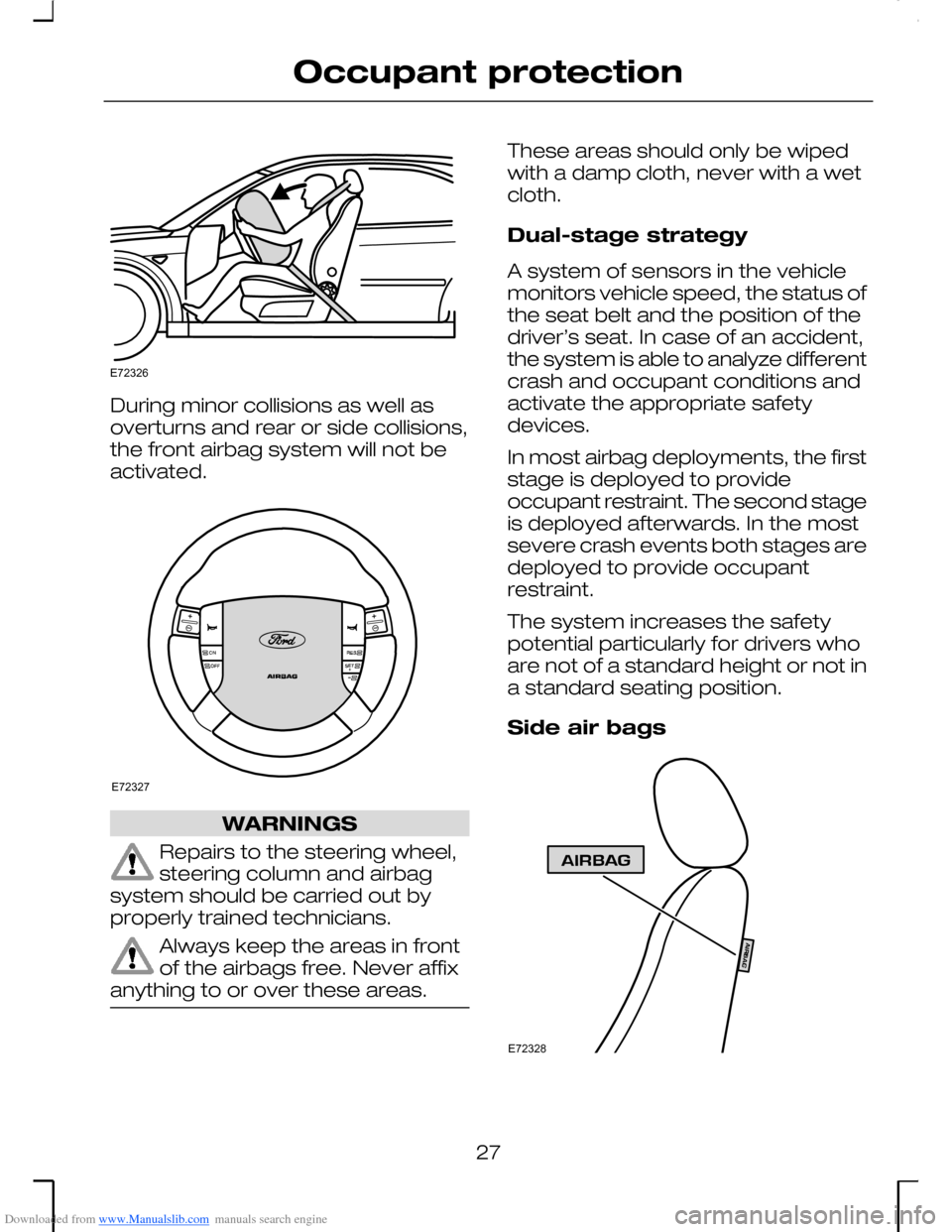
Downloaded from www.Manualslib.com manuals search engine During minor collisions as well asoverturns and rear or side collisions,the front airbag system will not beactivated.
WARNINGS
Repairs to the steering wheel,steering column and airbagsystem should be carried out byproperly trained technicians.
Always keep the areas in frontof the airbags free. Never affixanything to or over these areas.
These areas should only be wipedwith a damp cloth, never with a wetcloth.
Dual-stage strategy
A system of sensors in the vehiclemonitors vehicle speed, the status ofthe seat belt and the position of thedriver’s seat. In case of an accident,the system is able to analyze differentcrash and occupant conditions andactivate the appropriate safetydevices.
In most airbag deployments, the firststage is deployed to provideoccupant restraint. The second stageis deployed afterwards. In the mostsevere crash events both stages aredeployed to provide occupantrestraint.
The system increases the safetypotential particularly for drivers whoare not of a standard height or not ina standard seating position.
Side air bags
27
Occupant protectionE72326 E72327 E72328
Page 30 of 198
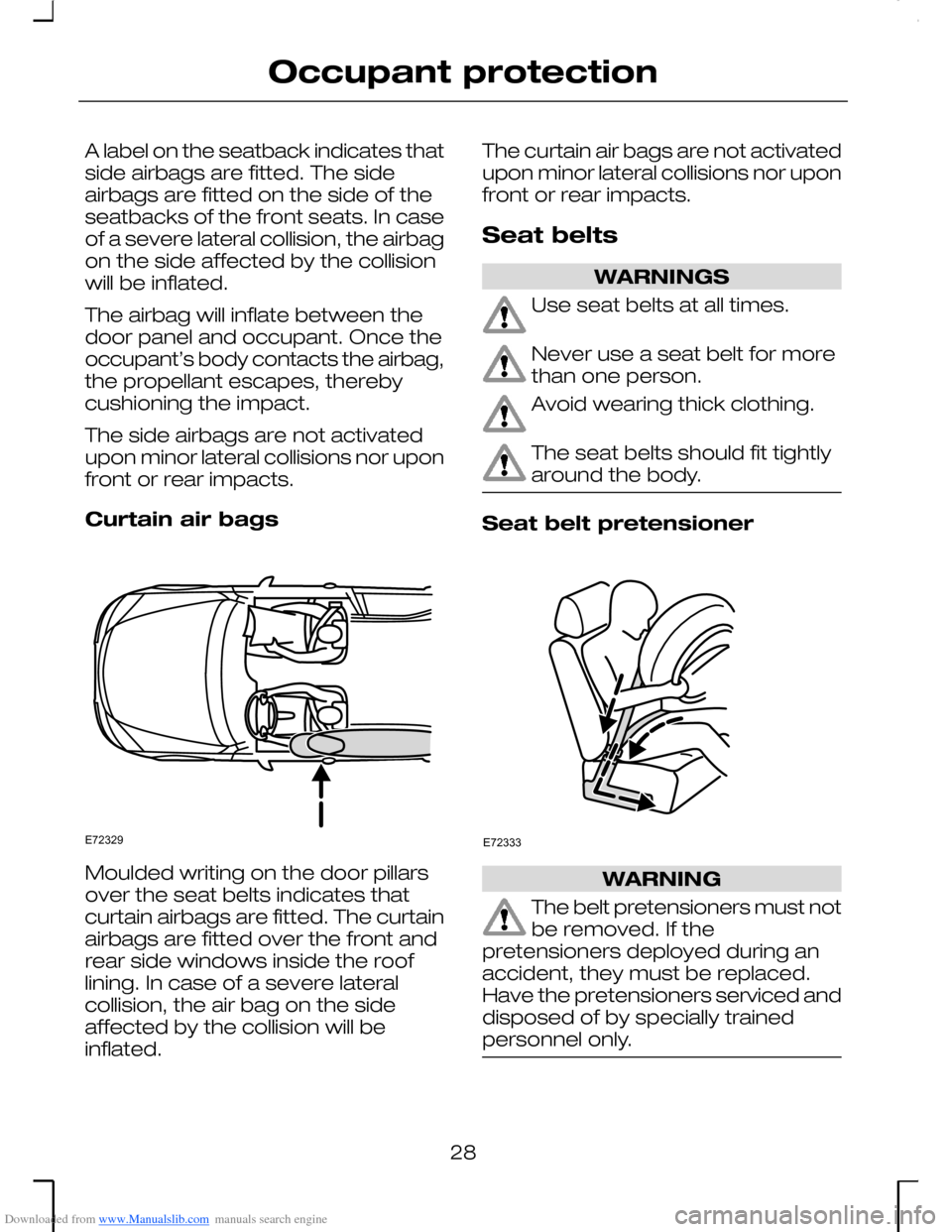
Downloaded from www.Manualslib.com manuals search engine A label on the seatback indicates thatside airbags are fitted. The sideairbags are fitted on the side of theseatbacks of the front seats. In caseof a severe lateral collision, the airbagon the side affected by the collisionwill be inflated.
The airbag will inflate between thedoor panel and occupant. Once theoccupant’s body contacts the airbag,the propellant escapes, therebycushioning the impact.
The side airbags are not activatedupon minor lateral collisions nor uponfront or rear impacts.
Curtain air bags
Moulded writing on the door pillarsover the seat belts indicates thatcurtain airbags are fitted. The curtainairbags are fitted over the front andrear side windows inside the rooflining. In case of a severe lateralcollision, the air bag on the sideaffected by the collision will beinflated.
The curtain air bags are not activatedupon minor lateral collisions nor uponfront or rear impacts.
Seat belts
WARNINGS
Use seat belts at all times.
Never use a seat belt for morethan one person.
Avoid wearing thick clothing.
The seat belts should fit tightlyaround the body.
Seat belt pretensioner
WARNING
The belt pretensioners must notbe removed. If thepretensioners deployed during anaccident, they must be replaced.Have the pretensioners serviced anddisposed of by specially trainedpersonnel only.
28
Occupant protectionE72329 E72333